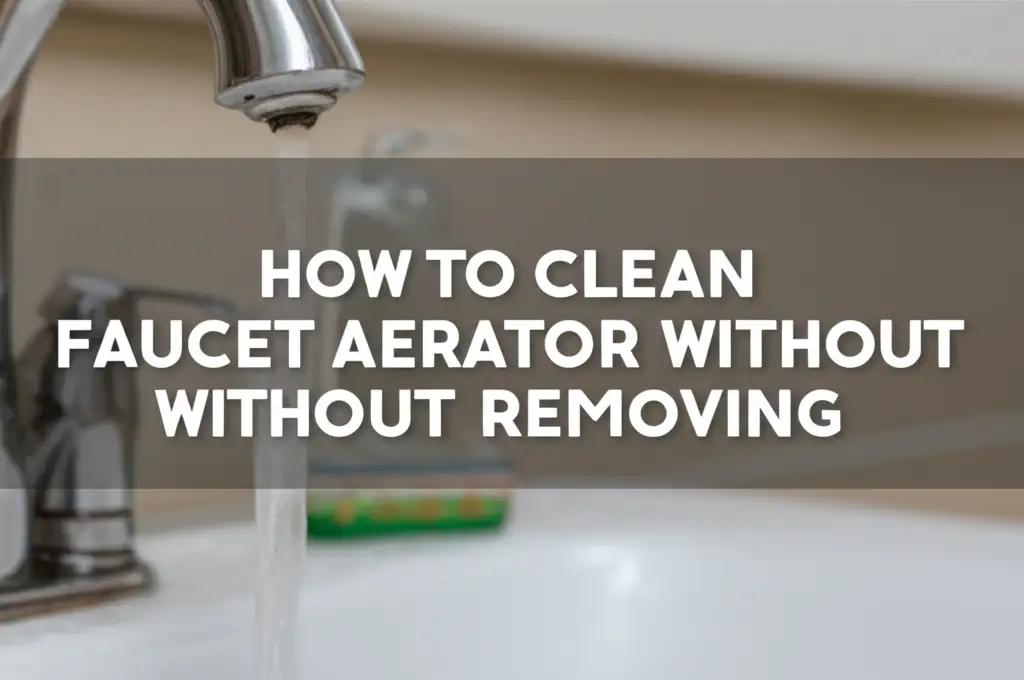· Home Maintenance · 13 min read
How To Clean Faucet Aerator Without Removing

How To Clean Faucet Aerator Without Removing It
Have you noticed your kitchen faucet spitting water or delivering a weak stream? Perhaps your bathroom faucet makes strange noises when you turn it on. The problem often lies with a clogged faucet aerator. This small, mesh screen device at the tip of your faucet helps regulate water flow and prevents splashing. Over time, mineral deposits, sediment, and debris build up inside it. This buildup reduces water pressure and can make your faucet look dirty.
Cleaning a faucet aerator often seems like a big task. Many people believe you must remove the aerator completely to clean it. This is not always true. I am here to share easy methods to clean faucet aerator without removing it. These techniques save you time and prevent potential damage to your faucet. This article will show you exactly what to do. You will learn about the necessary tools and detailed steps for effective cleaning. Get ready to restore excellent water flow to your faucets.
Takeaway
- You can effectively clean a clogged faucet aerator without needing to remove it.
- The primary method involves soaking the aerator in vinegar using a plastic bag.
- Regular cleaning prevents mineral buildup and maintains good water flow.
The main query is: How do I clean a faucet aerator without removing it? You can clean a faucet aerator without removing it by soaking it. Attach a plastic bag filled with white vinegar to the faucet tip. Ensure the aerator is fully submerged. Let it sit for several hours or overnight. This method dissolves mineral deposits and clears blockages effectively.
Understanding Your Faucet Aerator and Its Importance
A faucet aerator is a small, round component at the end of your faucet spout. It mixes air with the water stream. This creates a steady, non-splashing flow. It also helps conserve water by reducing the overall flow rate. Most aerators have multiple layers of mesh screens. These screens catch sediment and mineral particles from your water supply.
Over time, these trapped particles accumulate. Hard water areas are especially prone to this issue. Minerals like calcium and magnesium cling to the screens. This buildup forms a hard crust. This crust narrows the path for water. You will notice a weaker water stream or an erratic spray. A dirty aerator can also harbor bacteria. This impacts the quality of your water for drinking or cooking.
Regular maintenance keeps your aerator functioning correctly. It ensures efficient water use. It also keeps your water clean. Ignoring a clogged aerator can lead to frustration. It can also cause other plumbing issues. Keeping it clean is a simple step for a healthier home. It also prolongs the life of your faucet.
Why Cleaning Without Removal Is a Smart Choice
Cleaning a faucet aerator without removing it offers many advantages. First, it simplifies the process. You do not need special tools like aerator wrenches. You avoid the risk of damaging the faucet finish. Some faucets have unique or integrated aerators. These are difficult to remove. Other aerators might be stuck due to corrosion. Trying to force them off can strip threads or scratch the faucet.
This non-removal method prevents potential leaks. If you remove an aerator, you might not seal it correctly when putting it back. This causes drips or leaks. It also saves time. You avoid searching for the right tool or dealing with stubborn parts. This method is also less messy. You keep the cleaning solution contained.
I find this approach helpful for quick maintenance. It is also good for those who are not comfortable with minor plumbing tasks. It lets you clean the aerator often. Frequent cleaning prevents severe blockages. It keeps your water flow consistent. This method is effective for most common aerator issues. It is a good first step before considering professional help.
Essential Tools and Materials for Non-Removal Cleaning
Before you start cleaning your faucet aerator, gather your supplies. You likely have most of these items at home. Preparation makes the process smooth and quick. You will need a few basic household items.
Here is a list of what you need:
- White Vinegar: This is your main cleaning agent. Vinegar is acidic. It effectively dissolves mineral deposits like limescale and calcium.
- Small Plastic Bag (sandwich or Ziploc bag): This bag will hold the vinegar. It allows you to submerge the aerator.
- Rubber Band or String: You will use this to secure the plastic bag to the faucet.
- Old Toothbrush or Small Scrub Brush: This helps scrub away loose debris after soaking.
- Microfiber Cloth or Soft Rag: For wiping down the faucet and aerator.
- Optional: Baking Soda: For tackling stubborn stains or a deeper clean.
- Optional: Lemon Juice: A natural alternative to vinegar for lighter buildup.
Make sure your plastic bag is free of holes. A leaking bag will make a mess. Choose a rubber band strong enough to hold the bag securely. I always keep these items handy under my sink. This way, I am ready for quick clean-ups. Having everything prepared makes the job easier. You will complete the task efficiently.
The Vinegar Soaking Method: Your Go-To Strategy
The vinegar soaking method is highly effective. It is also very simple. This technique uses the power of white vinegar to dissolve mineral buildup. It cleans your faucet aerator without needing to remove it. I use this method frequently. It works wonders on hard water stains.
Here are the step-by-step instructions:
- Gather Your Supplies: Get your white vinegar, a small plastic bag, and a rubber band.
- Pour Vinegar into Bag: Fill the plastic bag with enough white vinegar to fully submerge the faucet aerator. You only need a few ounces.
- Position the Bag: Carefully place the bag over the faucet spout. Make sure the aerator is completely immersed in the vinegar. Push the bag up firmly against the faucet.
- Secure the Bag: Use a strong rubber band to secure the top of the bag around the faucet spout. Ensure it is tight. This prevents the bag from slipping or leaking. You want the vinegar to stay in place.
- Let It Soak: Allow the aerator to soak for at least 3-4 hours. For severe buildup, let it soak overnight (8-12 hours). The longer it soaks, the better the vinegar can dissolve the mineral deposits.
- Remove and Rinse: Carefully remove the rubber band and the plastic bag. Pour out the vinegar.
- Scrub (if needed): Turn on the hot water. Let it run for a few minutes. This flushes out loosened particles. If you still see buildup, use an old toothbrush. Gently scrub the aerator openings. You can also clean buildup on faucet surfaces at this time.
- Wipe Down: Use a clean, soft cloth to wipe the faucet and aerator dry. This restores its shine.
This method is powerful. It breaks down even stubborn mineral deposits. It clears your aerator. Your water flow will improve significantly.
Baking Soda and Brush Method for Stubborn Buildup
Sometimes, vinegar alone needs a little help. For very stubborn mineral buildup or grime, combining baking soda with a good scrubbing can be necessary. This method works well for visible gunk that the vinegar soak loosened but did not completely remove. It gives you a physical scrubbing action. This helps dislodge remaining particles.
Here is how I tackle really tough aerator grime:
- Perform Initial Vinegar Soak: First, follow the vinegar soaking method described above. This softens the deposits. It makes them easier to remove. I always start with the soak.
- Prepare Baking Soda Paste: After soaking, remove the bag. If residue remains, mix a small amount of baking soda with a few drops of water. Create a thick paste. This paste acts as a gentle abrasive. It helps scrub away the softened grime.
- Apply and Scrub: Apply the baking soda paste directly onto the aerator. Use an old toothbrush or a small scrub brush. Gently scrub the aerator’s mesh and exterior. Focus on areas with visible buildup. The bristles can reach into small openings. This dislodges any stubborn bits.
- Rinse Thoroughly: Turn on the water. Let it run for several minutes. This rinses away the baking soda paste and any dislodged debris. Use both cold and hot water. This ensures everything is flushed out. I sometimes run water and scrub simultaneously for a final rinse.
- Wipe and Inspect: Wipe the faucet and aerator with a clean cloth. Inspect the water flow. It should be strong and steady. If the flow is still weak, repeat the scrubbing process. You might also consider another short vinegar soak.
This combined approach tackles most aerator blockages. It restores your faucet’s performance. It is a powerful duo for cleaning without taking things apart. You can also apply similar methods to clean your kitchen faucet spray head if it also has buildup issues.
Addressing Different Faucet Types and Special Considerations
While the vinegar soaking method is versatile, different faucet types may require slight adjustments. Understanding these nuances helps you achieve the best results. Whether it is a kitchen faucet, a bathroom sink faucet, or a pull-down sprayer, the core concept remains the same: soak the aerator in vinegar. However, the exact positioning of the bag or the cleaning tools might vary.
Kitchen Faucets
Kitchen faucets often have larger aerators. They handle more water volume. This means they can accumulate more debris. For these, ensure your plastic bag is large enough. It must cover the entire aerator. You might need a gallon-sized bag. For cleaning vent covers without removing them, a similar bagging and soaking method applies. The principle of not disassembling is key.
Bathroom Faucets
Bathroom faucets usually have smaller aerators. They are also closer to the sink basin. This can make attaching the bag a bit trickier. Use a smaller sandwich bag. Ensure it fits snugly. You may need to angle the faucet if possible. This allows for full submersion.
Pull-Down or Pull-Out Spray Faucets
These faucets are common in kitchens. Their aerators are often integrated into the spray head. This design makes removal even more challenging. The good news is the vinegar soak works perfectly here. Pull the spray head down. Position the bag so the aerator is fully submerged. Use a rubber band around the hose or neck of the spray head to secure it. This method works well for hard-to-reach areas. It is like cleaning a bathroom exhaust fan without removing the entire unit; you target the accessible parts.
Faucets with Unusual Shapes
Some modern faucets have unique designs. Their aerators might be recessed or oddly shaped. For these, ensure the bag completely seals around the opening. You might need duct tape to secure the bag if a rubber band does not work. Just be careful not to damage the finish. Always test a small, hidden area first.
Remember to consider the faucet’s material. While vinegar is safe for most finishes, prolonged contact with delicate finishes might cause issues. Always rinse thoroughly after cleaning. This removes all vinegar residue.
Preventative Measures and Regular Maintenance
Cleaning your faucet aerator is not just a one-time fix. Regular maintenance keeps your water flowing perfectly. It also prevents severe mineral buildup. I recommend making aerator cleaning a part of your regular home cleaning routine. This proactive approach saves you hassle later.
Here are some tips for prevention and maintenance:
- Routine Soaking: Perform the vinegar soaking method every 1-3 months. This depends on your water hardness. If you have very hard water, clean more often. This prevents deposits from hardening. It also keeps the aerator clear.
- Daily Wiping: After each use, quickly wipe the faucet spout and aerator with a soft cloth. This removes water spots. It also stops mineral residue from building up on the surface.
- Use Water Filters: Consider installing a whole-house water filter. Or use a faucet-mounted filter. These filters reduce sediment and mineral content in your water. This lessens the burden on your aerator.
- Check for Leaks: Address any faucet leaks promptly. Even minor drips can contribute to mineral buildup around the aerator.
- Avoid Harsh Chemicals: Do not use abrasive cleaners or harsh chemicals on your faucet. These can damage the finish. They can also corrode the aerator components. Stick to natural cleaners like vinegar and baking soda.
- Educate Family Members: Let everyone in your household know about basic faucet care. Simple habits make a big difference. For instance, wiping the faucet dry after use.
By following these simple steps, you extend the life of your faucet. You also maintain optimal water pressure. Clean faucets contribute to a cleaner, more efficient home environment. Regular, gentle care is the key.
FAQ Section
How often should I clean my faucet aerator?
The frequency depends on your water hardness. For hard water areas, I recommend cleaning every 1-3 months. If you have soft water, every 6 months might be enough. Look for reduced water flow or erratic spray as signs it is time to clean.
What causes a faucet aerator to get clogged?
Mineral deposits are the most common cause. Hard water contains calcium and magnesium. These minerals build up over time. Sediment, rust, and other debris from your water pipes can also clog the aerator.
Can I use something other than vinegar to clean my aerator?
Yes, lemon juice is another natural acidic option. It works similarly to vinegar. For very light buildup, hot soapy water might help. However, white vinegar is usually the most effective household solution for mineral deposits. Avoid harsh chemical cleaners.
Will cleaning the aerator without removing it damage my faucet?
No, the vinegar soaking method is very safe for most faucet finishes. It is a gentle approach. You avoid the risk of scratching the finish or damaging threads that can happen with removal. Always rinse thoroughly after cleaning.
What if my water pressure does not improve after cleaning?
If cleaning the aerator does not fix the low water pressure, the problem might be elsewhere. The issue could be deeper in the faucet. It could be in the water lines. Or it could be a whole-house water pressure problem. You might need to consult a plumber.
Can I prevent aerator clogs entirely?
You cannot prevent clogs entirely, especially with hard water. However, you can significantly reduce their frequency and severity. Regular cleaning, using water filters, and addressing faucet leaks quickly are excellent preventative measures.
Conclusion
You now know how to clean faucet aerator without removing it. This simple yet effective process saves you time and effort. It helps maintain your home’s plumbing. You have learned that mineral buildup is a common culprit for weak water flow. The vinegar soaking method, combined with a quick scrub, is your go-to solution. This method requires minimal tools. It protects your faucet from damage. It also makes your water flow smooth and strong again.
Regular maintenance is key. Cleaning your aerators every few months prevents major clogs. It also ensures efficient water use. I encourage you to try these methods today. You will be surprised at the difference a clean aerator makes. Keep your faucets running their best. Enjoy consistent, clear water flow in your home.
- faucet cleaning
- aerator maintenance
- hard water stains
- DIY plumbing
- home cleaning tips




